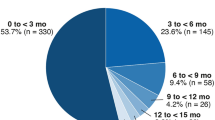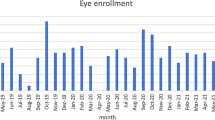Abstract
Purpose
We aimed to evaluate the long-term natural history of polypoidal choroidal vasculopathy (PCV) in untreated patients.
Methods
This is a retrospective observational case series. Patients with symptomatic PCV who did not receive any treatment for at least 12 months were included from the records of three ophthalmic clinics in Asia. The medical records and imaging data were reviewed. Visual outcomes at month 12 and at last follow-up were analyzed. The influence of demographics and presenting features on visual outcome was analyzed.
Results
A total of 32 eyes (32 patients) were included in this analysis. The mean follow-up was 59.9 months (range, 18–119 months), the mean age was 65.7 years and 21 (65.6 %) patients were male. The mean presenting logMAR visual acuity was 0.79 (Standard deviation [SD] 0.49). The center of the fovea was involved by the PCV complex in 25 eyes (78.1 %). The mean greatest linear dimension (GLD) of the PCV complex was 2584 μm (SD 880). Twenty-three eyes (71.9 %) had a cluster-of-grapes configuration on indocyanine green angiography. Leakage of fluorescein angiography was present in 29 eyes (90.6 %). The mean logMAR vision deteriorated from 0.79 at baseline to 0.88 at month 12 (p = 0.11), and further to 1.14 (p = 0.003) at the last follow-up. The proportion of eyes that improved, remained unchanged and worsened was 21.9 %, 31.3 % and 46.9 %, respectively, at month 12; and 28.1 %, 9.4 % and 62.5 %, respectively, at last follow-up. The proportion of eyes with logMAR vision worse than 1.0 was 28.1 % at presentation, and increased to 31.3 % at month 12 and further to 53.1 % at last follow-up. Reasons for poor vision were due to retinal, subretinal or vitreous hemorrhage, and retinal pigment epithelium (RPE) atrophy and scarring. None of the presenting features were found to significantly influence visual outcome.
Conclusions
Half of eyes presenting with symptomatic PCV had a relatively benign course without treatment and some even had vision improvement. However, in the remaining eyes, vision deteriorated significantly, mainly due to hemorrhage and scarring. There may be subtypes of PCV with divergent natural history.


Similar content being viewed by others
References
Wong WL, Su X, Li X, Cheung CM, Klein R, Cheng CY, Wong TY (2014) Global prevalence of age-related macular degeneration and disease burden projection for 2020 and 2040: a systematic review and meta-analysis. Lancet Glob Health 2:e106–16
Jonas JB (2014) Global prevalence of age-related macular degeneration. Lancet Glob Health 2:e65–6
Wong TY, Chakravarthy U, Klein R, Mitchell P, Zlateva G, Buggage R, Fahrbach K, Probst C, Sledge I (2008) The natural history and prognosis of neovascular age-related macular degeneration: a systematic review of the literature and meta-analysis. Ophthalmology 115:116–26
Chakravarthy U, Evans J, Rosenfeld PJ (2010) Age related macular degeneration. BMJ 340:526–30
Laude A, Cackett PD, Vithana EN, Yeo IY, Wong D, Koh AH, Wong TY, Aung T (2009) Polypoidal choroidal vasculopathy and neovascular age-related macular degeneration: Same or different disease? Prog Ret Eye Res 29:19–29
Yannuzzi LA, Wong DW, Sforzolini BS, Goldbaum M, Tang KC, Spaide RF, Freund KB, Slakter JS, Guyer DR, Sorenson JA, Fisher Y, Maberley D, Orlock DA (1999) Polypoidal choroidal vasculopathy and neovascularized age-related macular degeneration. Arch Ophthalmol 117:1503–10
Yannuzzi LA, Ciardella A, Spaide RF, Rabb M, Freund KB, Orlock DA (1997) The expanding clinical spectrum of idiopathic polypoidal choroidal vasculopathy. Arch Ophthalmol 115:478–85
Perkovich BT, Zakov ZN, Berlin LA, Weidenthal D, Avins LR (1990) An update on multiple recurrent serosanguineous retinal pigment epithelial detachments in black women. Retina 10:18–26
Okubo A, Arimura N, Abematsu N, Sakamoto T (2010) Predictive signs of benign course of polypoidal choroidal vasculopathy: based upon the long-term observation of non-treated eyes. Acta Ophthalmol 88:e107–14
Moorthy RS, Lyon AT, Rabb MF, Spaide RF, Yanuzzi LA, Jampol LM (1998) Idiopathic polypoidal choroidal vasculopathy of the macula. Ophthalmology 105:1380–5
Yamaoka S, Okada AA, Sugahara M, Hida T (2010) Clinical features of polypoidal choroidal vasculopathy and visual outcomes in the absences of classic choroidal neovascularization. Ophthalmologica 224:147–52
Bessho H, Honda S, Imai H, Negi A (2011) Natural course and funduscopic findings of polypoidal choroidal vasculopathy in a Japanese population over 1 year of follow-up. Retina 31:501–15
Uyama M, Wada M, Nagai Y, Matsubara T, Matsunaga H, Fukushima I, Takahashi K, Matsumura M (2002) Polypoidal choroidal vasculopathy: natural history. Am J Ophthalmol 133:639–48
Sho K, Takahashi K, Yamada H, Wada M, Nagai Y, Otsuji T, Nishikawa M, Mitsuma Y, Yamazaki Y, Matsumura M, Uyama M (2003) Polypoidal choroidal vasculopathy. Incidence, demographic features and clinical characteristics. Arch Ophthalmol 121:1392–6
Okubo A, Sameshima M, Sakamoto T (2004) Plasticity of polypoidal lesions in polypoidal choroidal vasculopathy. Graefes Arch Clin Exp Ophthalmol 242:962–5
Musashi K, Tsujikawa A, Hirami Y, Otani A, Yodoi Y, Tamura H, Yoshimura N (2007) Microrips of the retinal pigment epithelium in polypoidal choroidal vasculopathy. Am J Ophthalmol 143:883–5
Chan WM, Lam DS, Lai TY, Liu DT, Li KK, Yao Y, Wong TH (2004) Photodynamic therapy with verteporfin for symptomatic polypoidal choroidal vasculopathy one-year results of a prospective case series. Ophthalmology 111:1576–1584
Gomi F, Ohji M, Sayanagi K, Sawa M, Sakaguchi H, Oshima Y, Ikuno Y, Yano Y (2008) One-year outcomes of photodynamic therapy in age-related macular degeneration and polypoidal choroidal vasculopathy in Japanese patients. Ophthalmology 115:141–146
Gomi F, Sawa M, Sakaguchi H, Tsujikawa M, Oshima Y, Kamei M, Tano Y (2008) Efficacy of intravitreal bevacizumab for polypoidal choroidal vasculopathy. Br J Ophthalmol 92:70–73
Lai TY, Chan WM, Liu DT, Luk FO, Lam DS (2008) Intravitreal bevacizumab (Avastin) with or without photodynamic therapy for the treatment of polypoidal choroidal vasclopathy. Br J Ophthalmol 92:661–666
Cheung CM, Bhargava M, Laude A, Koh ACH, Xiang L, Wong D, Niang T, Lim TH, Gopal L, Wong TY et al (2012) Asian age-related macular degeneration phenotyping study: rationale, design and protocol of a prospective cohort study. Clin Exp Ophthalmol 40:727–35
Kwok AK, Lai TY, Chan CW, Neoh EL, Lam DS (2002) Polypoidal choroidal vasculopathy in Chinese patients. Br J Ophthalmol 86:892–7
Pauleikoff D, Löffert D, Spital G, Radermacher M, Dohrmann J, Lommatzsch A, Bird AC (2002) Pigment epitheilial detachment in the elderly. Clinical differentiation, natural course and pathogenetic implications. Graefes Arch Clin Exp Ophthalmol 240:533–8
Lee WK, Kim KS, Kim W, Lee SB, Jeon S (2012) Responses to photodynamic therapy in patients with polypoidal choroidal vasculopathy consisting of polyps resembling grape clusters. Am J Ophthalmol 154:355–65
Cackett P, Wong D, Yeo I (2009) A classification system for polypoidal choroidal vasculopathy. Retina 29:187–91
Yuzawa M, Mori R, Kawamura A (2005) The origins of polypoidal choroidal vasculopathy. Br J Ophthalmol 89:602–7
Byeon SH, Lew YJ, Lee SC, Kwon OW (2010) Clinical features and follow-up results of pulsating polypoidal choroidal vasculopathy treated with photodynamic therapy. Acta Ophthalmol 88:660–8
Okubo A, Ito M, Sameshima M, Uemura A, Sakamoto T (2005) Pulsatile blood flow in the polypoidal choroidal vasculopathy. Ophthalmology 112:1436–41
Koh A, Lee WK, Chen LJ et al (2012) EVEREST study: efficacy and safety of verteporfin photodynamic therapy in combination with ranibizumab or alone versus ranibizumab monotherapy in patients with symptomatic macular polypoidal choroidal vasculopathy. Retina 32:1453–64
Uyama M, Matsubara T, Fukushima I, Matsunaga H, Iwashita K, Nagai Y, Takahashi K (1999) Idiopathic polypoidal choroidal vasculopathy in Japanese patients. Arch Ophthalmol 117:1035–42
Okubo A, Hirakawa M, Ito M, Samehima M, Sakamoto T (2008) Clinical features of early and late stage polypoidal choroidal vasculopathy characterized by lesion size and disease duration. Graefes Arch Clin Exp Ophthalmol 246:491–9
Tamura H, Tsujikawa A, Otani A et al (2007) Polypoidal choroidal vasculopathy appearing as classic choroidal neovascularization on fluorescein angiography. Br J Ophthalmol 91:1152–9
Maruko I, Iida T, Saito M, Nagayama D, Saito K (2007) Clinical characteristics of exudative age-related macular degeneration in Japanese patients. Am J Ophthalmol 144:15–22
Maruko I, Iida T, Saito M, Nagayama D (2010) Combined cases of polypoidal choroidal vasculopathy and typeical age-related macular degeneration. Graefes Arch Clin Exp Ophthalmol 248:361–8
Funding source
This study was supported by National Medical Research Council grant NMRC/NIG/1003/2009.
Conflict of interest
None.
Author information
Authors and Affiliations
Corresponding author
Rights and permissions
About this article
Cite this article
Cheung, C.M.G., Yang, E., Lee, W.K. et al. The natural history of polypoidal choroidal vasculopathy: a multi-center series of untreated Asian patients. Graefes Arch Clin Exp Ophthalmol 253, 2075–2085 (2015). https://doi.org/10.1007/s00417-015-2933-2
Received:
Revised:
Accepted:
Published:
Issue Date:
DOI: https://doi.org/10.1007/s00417-015-2933-2




